Depth Analysis of LED Street Light Vs HPS Lamp, LED vs HPS Street Lights, Which is Better
1780Depth Analysis of LED Street Light Vs HPS Lamp, LED vs HPS Street Lights, Which is Better
View detailsGuide of All in One Solar LED Street Lights(Updated in 2022)
Are you looking for a solar-energy-based illuminating solution for either your own courtyards or some public sites, such as playgrounds, pathways, parking lots, plazas, etc?
Or, you are upset about the short autonomy of your current solar street lights with traditional technology, which, sometimes, especially during monsoon, have to subsist on the national electricity grid?
(some hybrid solar street lights systems are grid-tied systems, they are designed to connect to the national electricity grid. When their own battery bank runs out of power, they will switch to the electricity grid.)However, things can be worse.
Your projects could be located in some remote rural areas or isolated islands, where no electricity can reach. How can your solar-powered street lights survive a spell of raining weather?
You may say we should increase the size of both battery bank and solar panels. Well, this sounds plausible in engineering respect, but when it comes to the project budget, this also means the raising of outlay significantly since the cost of battery accounts for a larger part.
Then, why not adopt the ones with advanced technology, all in one solar street lights.
Without further ado, let’s dive right in: Contents
All in one solar street lights are one type of integrated solar street lights, which integrates into a product the four main components: solar panel, light source, battery, solar energy cables, and solar controller. Now let’s go through the details of each module one by one
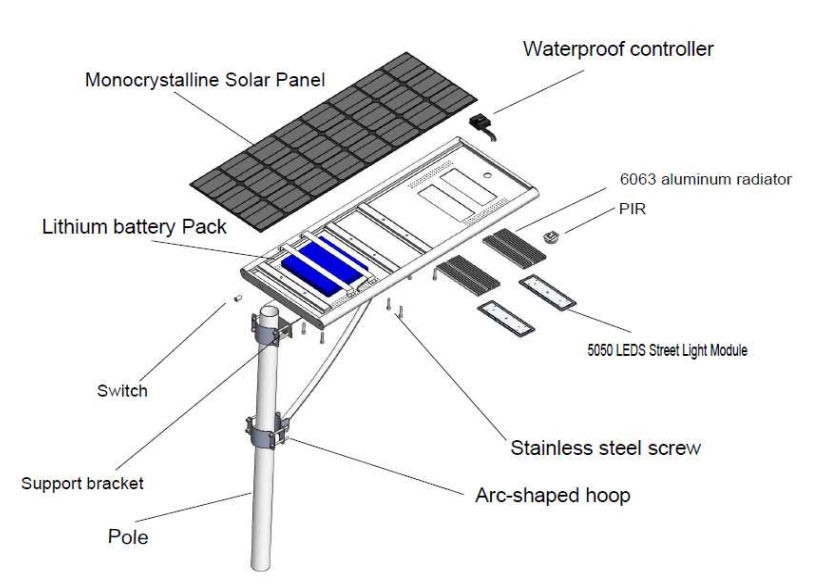
# Monocrystalline Solar Panel
Monocrystalline and polycrystalline solar panels are two different solar panels which are widely applied in the solar industry.
Generally speaking, monocrystalline performs better than polycrystalline, especially in cold weather they have higher energy conversion rates than polycrystalline. To data, Sunpower monocrystalline solar panel can reach as much as 24.1% conversion rates.
So, Monocrystalline panels are installed in all in one solar street lights due to its limited size.
These solar panels act as the role of energy collecting and conversion, in the daytime, they collect energy from the sun and then convert them into electric power which will be stored in batteries as chemical energy.
# LED Light source
Suffice it to say, as light sources LEDs are prevailing among illuminating market, for its high performance in energy-saving. It definitely can be counted as a new generation of lighting solution.
LED types vary in size and watts, such as 3528, 3030, 5050, 5630, to adapt to different applications.
Our S2 series integrated solar street lights is with Philips LUXEON 3030 SMD, which has almost 190 lumens per watt. A LED module is formed by these single 3030 SMDs which are soldered to an aluminum substrate in advance.
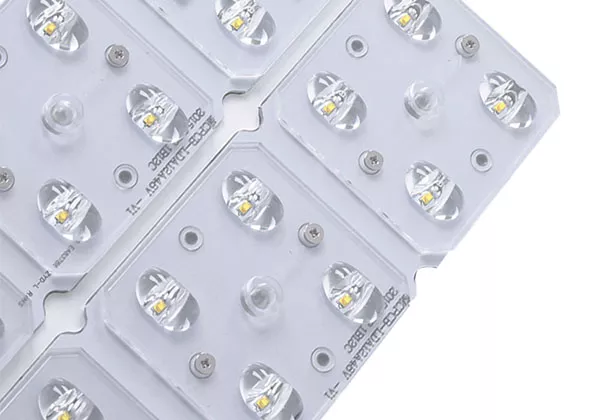
Furthermore, an aluminum heatsink is always applied to the rear side of the led modules to help dissipate the heat generated by LEDs. This is very important, for although manufacturers claim that LED has a lifespan of more than 50,000 hours, its light depreciation can be abnormally high if it is working in a temperature larger than 70 Celsius. So we must make sure that the LED junction temperature is under 70 Celsius.
# Lithium-ion Battery
Rather than car batteries, which are designed to discharge a large amount of energy in a short period of time, renewable energy industries prefer deep-cycle batteries, for their excellent characteristics in the enduring power supply, deep discharges and far more cycle times, 3000 times, twice or three times more than that of car batteries.
Batteries cycle times is also affected by the depth of discharge(DoD), we will talk more in Chapter 5.
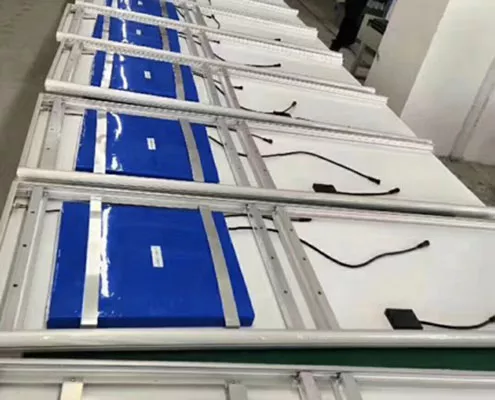
There are two main types of deep-cycle batteries existed in the solar battery market: lead acid and lithium.
Why do all in one solar street lights use lithium-ion battery?
5 Reasons:
However, manufacturers often use two types of lithium-ion battery
Difference between them?
Diameter (mm) | Length (mm) | Part Number | Typical voltage | The typical voltage of battery package | price | Working temperature | Declared cycle times | |
| Ternary lithium battery | 18 | 65 | 18650 | 3.7v | 11.1v | cheaper | -30 to 65 Celsius | 1500 times |
| LiFePO4 lithium battery | 26 | 65 | 26650 | 3.2v | 12.8v | almost twice the price of 18650 | -10 to 75 Celsius | 1200 times |
Lithium Iron Phosphate (LiFePO4) Battery (LEFT) VS Ternary Lithium Battery (RIGHT)
What kind of lithium-ion battery should I use in my projects?
What we have learned, from the comparison table above, is that LiFePO4 battery is more expensive, but its chemical substance inside is more stable, which makes it kind of high-temperature resistance, while ternary lithium battery is relatively low-temperature resistance, for its materials are more active and can work under 0 Celsius.
So, if your project is in the tropics, LiFePO4 battery is recommended. But if the project is in northern countries, we advise ternary lithium battery.
# MPPT Solar Charge Controller
There are 2 types of controller: PWM and MPPT in the market.
All in one solar led street lights adopts MPPT, for, in this case, PWM will waste some energy collected by panels, while MPPT can convert all the solar energy collected into chemical energy
As the main functional component, MPPT solar charge controllers have some basic functions as below
1. Dusk to dawn control
The controller is always monitoring the voltage of the solar panel, which increases or decreases with the intensity of the sunlight. When it is lower than 5v, towards dusk, the control will switch on the LED lights. And when it is towards daybreak and the voltage is larger than 5v, the LED lights will be turned off.
2. Time control
The solar controller can also control the power output according to the time schedule, for instance, you want
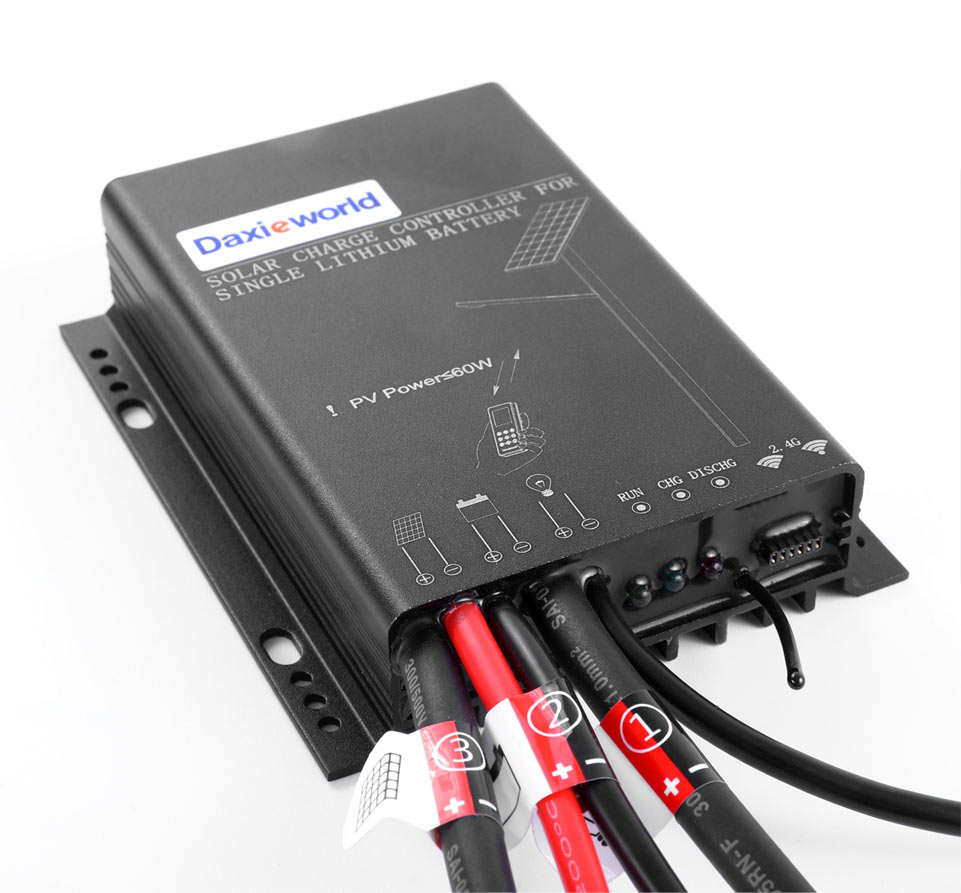
Commonly, a controller has around 5 time-slots you can use to set according to different requirements of projects.
Time control is often used in conjunction with motion sensor control. For example, from 11:00 pm to 5:00 am, there are few people on the road, so you can set only 30% power during this period, meanwhile, only capitalizing on the motion sensor to raise power to 100% when a passer-by is detected.
By doing this, we can save a lot of energy to boost the duration of off-grid solar street lights and ramp up the days of autonomy.
3. Motion sensor control
A controller can take action when it receives a signal from the motion sensor to increase LED brightness when someone is in sensor area, and then revert to the former level of brightness when it moves out of the area.
4. Preventing overcharge and Low voltage disconnect(LVD)
Either overcharge or over discharge can dramatically reduce the lifespan of batteries, although batteries modules themselves have this sort of protection, solar charge controllers usually have the same function analogous to that of battery modules. But be rest assured, the two are not conflicting with each other, for they function in different dimensions.
# Infrared(PIR) Motion sensor
Infrared and microwave motion sensor are two popular types in all in one integrated solar street lights, the infrared motion sensor detects heat source movement, while microwave ones send microwave radar and receive the bounced signals to analyze the changes in bounced signals.
Our all in one solar street lights incorporate infrared types, which have a 120-degree working angle and can detect a squat cone space under the lights.
We do not prefer microwave ones, although they have a larger working angle, they are rather too sensitive and more likely to respond to some wrong movements, such as swaying trees, fluttering birds and flapping flags. Those wrong response could consume lots of gratuitous battery energy, and that’s what we do not expect.
Above is the introduction of the primary components.
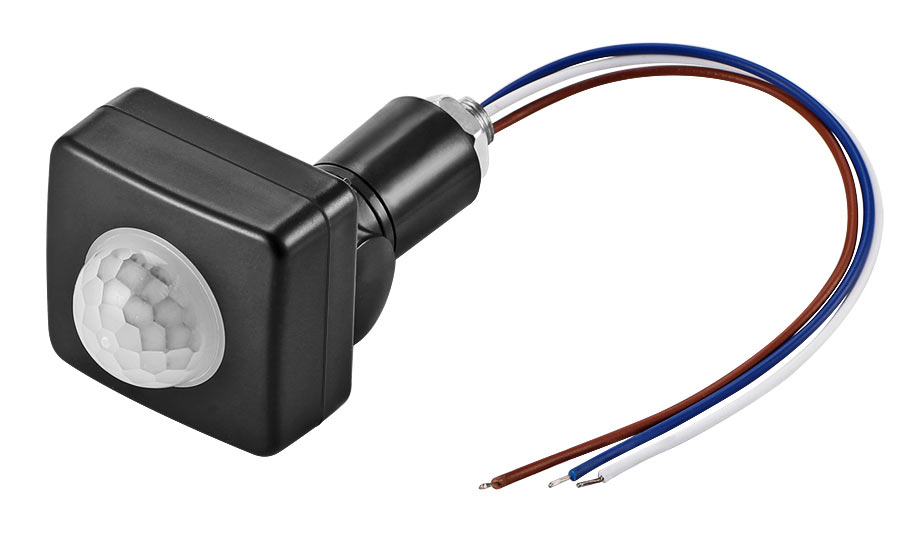
However, as integrated solar street lights, all in one solar street lights can also integrate some other functioning modules, such as Bluetooth, CCTV(Closed Circuit TV), or even wireless monitoring system, which enables end-users to monitor the status of each lights or even to control every lights by PC or mobile phone at any places where there are internet services.
Then, How do all these modules work as a complete system? We will talk about the working process in 2 aspects:
#Charging
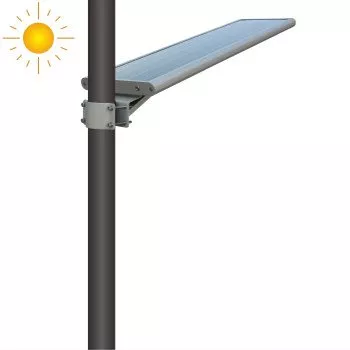
Auto-charging during the day
First, the solar charge controller will turn off LED lights towards dawn once solar panel voltage rise to 5v, which is accounted for a little sunlight in the morning.
When there is enough sunshine during the day, the solar panel will work together with the solar charge controller to collect the solar energy.
Commonly, in a 12v solar system, with the effect of insolation, the voltage of its solar panel will rise to around 18v so as to charge the 12v battery bank. Meanwhile, the solar charge controller will prevent overcharge to protect the batteries.
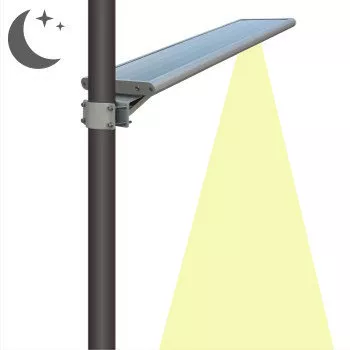
LED turns on automatically at night
When there is not enough sunlight towards dusk and solar panel voltage drops to a value under 5v, the LEDs will be turned on accordingly.
“Time control mode” and “Motion sensor control mode” will be working during discharging at night.
As primary function, Time control is used to customize different brightness in different time slots. For example:
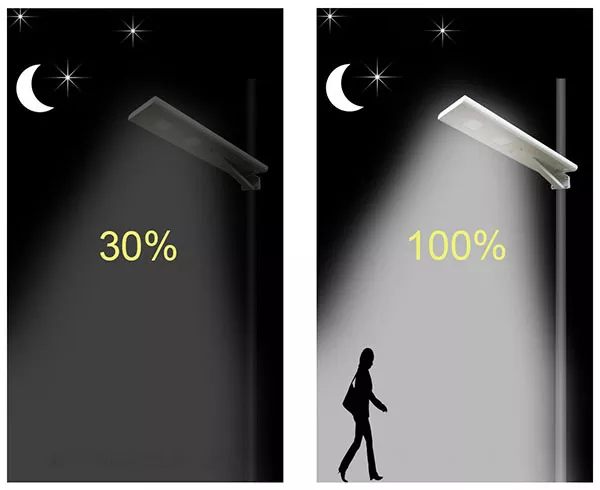
Motion sensor function
a motion sensor is used as a minor function which can be recognized as an energy-saving mode
The LEDs’ brightness will rise to 100% when someone is approaching the lights and then revert to the previous level of brightness 20 seconds after the man leaves.
In the past, why people do not tend to choose solar-powered street lights is due to three major reasons,
1. Lighting bulbs are energy consuming
Both MH(metal halide) and HPS (high-pressure sodium), which were used as light source in streetlights at that time, are with the relatively obsolete lighting technology (60-80 lumens/w) compared with that of the LED. those bulbs/lamps usually require a large amount of energy per day from its battery bank, which is considered as a downright burden to its battery capacity.
2. The LED technology is newly-developed and pretty expensive
In those days, although LEDs had been on the market in commercial outdoor lighting for a few years, the technology was still not mature. Their lighting efficiency was only 100 lumens/watt (now, in 2019, it can be up to 200 lumens/watt). Furthermore, since LEDs were newly-developed at that time, the cost was rather expensive and the average man on the street could not afford to buy.
3. Lithium-ion battery technology is not well developed
The third reason is the solar battery. The lithium-ion battery has the longest lifespan as one kind of deep cycle batteries, but they were not stable and would fail to work under 0 Celsius. (now, the working temperature of ternary lithium battery: -30 to 65 Celsius)
However, Things have changed over years.
The size of both batteries and lighting sources is increasingly small nowadays.
Thanks for the technological breakthrough in both the lithium-ion battery and LED lighting. These developments make it possible for the solar lighting industry to develop integrated solar street lights.
1. Battery Lead acid batteries VS. lithium-ion battery
Compared with lead acid batteries, lithium batteries are lighter, smaller, with longer lifespan and larger DoD, what is more important is that lithium batteries are with larger capacity at the same volume.
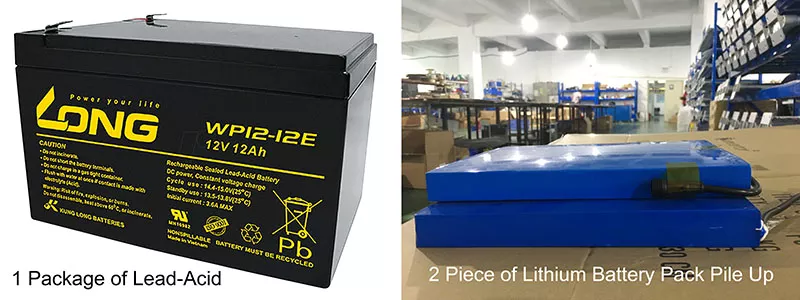
2. Light source
Compared with MH/HPS bulbs, LED takes up far less space in the lamps
1. No wiring, and easy to install within a few minutes
there is no complex wiring process, even if you are the end-users, you do not have to be with an engineering background or skills of setting electrical equipment, all you need to do is fixing the product with 12 pieces of fastening screws. Your family will stand to benefit from the free solar energy all the time.
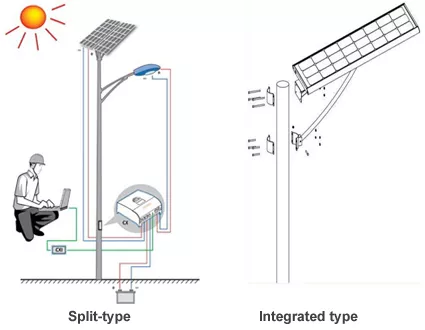
2. 60% less energy consumption, which also means more days of autonomy
The light sources of most conventional solar street lights were Metal Halide(MH) or High-Pressure Sodium(HPS), which luminous efficacy is only 60-80 lumens per watt. However, nowadays, the cutting-edge LED lighting technology has dramatically boosted it up to about 200 lumens per watt. People can get the same brightness at night by consuming much less energy from solar batteries.
All in one solar street lights with this kind of light source easily realize 5+ days autonomy, making it possible to work normally in places with rainy seasons or less insolation.
3. Better hurricane/typhoon resistance ability
All in one integrated solar street lights are designed with compact structure, compared with that of split-types, which solar panel are separated from the lamp. This kind of structure has better performance in withstanding hurricane/typhoon.
Split-type solar street light will not withstand such inclement weather since its separated solar panels are more likely to be shredded by storms.
4. Lower transportation cost benefits from compact structure and all-in-one design
If you are a businessman, compact design means a lot to your profit margin.
The whole container loads of solar street lights could be twice or even three times more than before, in the meantime, the rent of the warehouse can cost much less than before.
Besides, due to the convenience of installation, which we talked in #1, your company will save even more local labor costs.And more…
Conventional solar street lights VS all in one solar led street lights
In this chapter, we will go through a concrete example by presenting a comparison table between them, so you can figure out the pros and cons more easily.
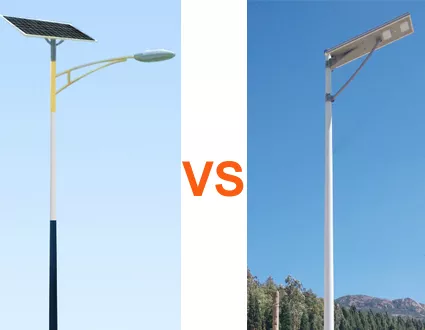
| Traditional solar street lights | All in one solar LED street lights | |
| basic | Split type | All-in-one type |
| Light source | MH (Metal Halide) | LED (Philips 3030 SMD) |
| energy saving mode | no | yes |
| connect to the electricity grid | grid-tied | goff-gridrid-tied |
| cables | With cables | No cables |
| request wiring skills | yes | no |
| autonomy days | autonomy days 3 days | 3 days |
| brightness | 3000 lumens | 3000 lumens |
| consumed power | 50 watts | 17 watts |
| light efficacy | 60 lumens / watts | 180 lumens / watts |
| working hours | 10 hours per day | 10 hours per day |
| battery type | sealed lead-acid | lithium-ion |
| battery size | 156 Ah | 27 Ah |
| solar panel size | 280 watts | 50 watts |
the same brightness, working hours, and days of autonomy,
But it is obvious, the upfront cost of all in one solar led street lights is fairly low,
it only needs 27Ah battery and 50 watts solar panel, whereas traditional solar street lights require 156 Ah and 280 watts, let alone other extra wiring costs that are entailed in installation.
needless to say, the quality of products is very important to businesses, sometimes, is crucial for winning tenders.
But can you always get a qualified all in one solar street light? I doubt it.
You might encounter problems:
Let’s dive in the content with these questions you may have.
For almost all kinds of integrated solar street lights, QC mainly focuses on the following items:
Let’s review each one in detail.
CCT & CRI
CCT & CRI are important optical factors for illuminating
CCT stands for correlated color temperature. lower value tends to yellow, while larger value tends to white and even with a little blueish color, refer to 8000K in the picture.
3000K looks like the sunlight at dusk or daybreak, the sunlight at noon is around 5000K, 6500K is called natural white, compact fluorescent lamp commonly has 6000-7000K.
Nowadays, nature white(6000-7000K) is always using in solar street lights.
Color rendering index (CRI) indicates how well a light source allows the substance to reflect its real color, the higher the CRI, the more an object can reflect its real color under this light source. Refer to the CRI 80 VS CRI 90
However, larger CRI also means more brightness loss as compensation. Namely, when we use the same chips to produce LED, if we make it with higher CRI, its brightness will be relatively dimmer than the one with lower CRI, so we commonly apply CRI 70 to the solar street light industry to get somewhat equilibrium.
Method
With the help of the integrating sphere, we can easily get the two optical parameters when inspecting the incoming raw materials. In fact, integrating sphere can also help to get even more electrical parameters, such as illuminance(brightness), lighting efficacy and so on.
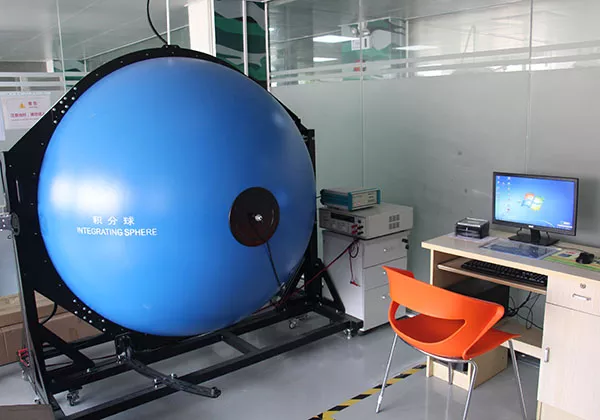
LM80 Standard
TYPICAL LM-80 DATA UP TO 10,000 HOURS, Source: Lumileds
LM80 is related to the lumen maintenance of LED, this standard requires the LED to meet the following table
| Working time(hours) | brightness depreciation(%) |
| 1,000 | 0 |
| 3,000 | <1% |
| 10,000 | <3% |
| 50,000 | <30% |
Since human eyes will not perceive the depreciation until it drops to 30%, an LM80 certified LED can definitely walk you through 50, 000 hours without becoming dim sensorily
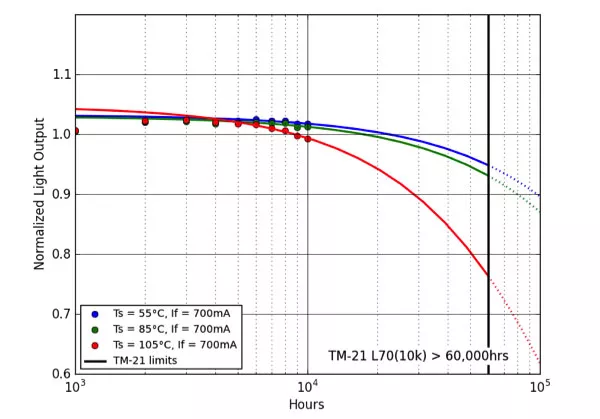
Method:
Some types of equipment are specially designed to do this test accordingly, although it is very expensive.
If you do not want to invest such huge and expensive facilities, our advice is to complete the job in a third party laboratory with little payment.
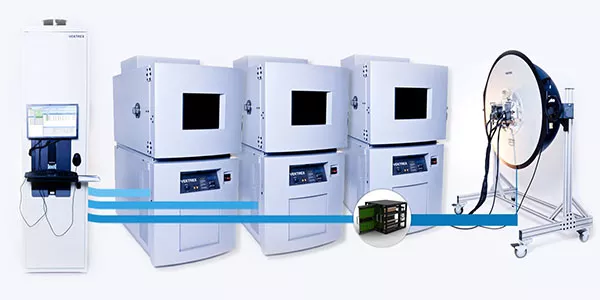
Battery cycle time
DoD vs. Cycle times
Battery seems to be the most vulnerable part, they have the higher failure rates than the others, its lifespan depends on not only the materials and workmanship but also how we use it, for examples, how many proportions of power is discharged before next charging, specifically, the depth of discharge (DoD)
In solar street lights systems, the larger proportion the batteries are discharged every day, the shorter its cycle times will be.
Batteries manufacturers declare the cycle times of their lithium battery to be 1000 – 1500 times, which is based on the scenario that the battery is almost fully discharged each time.
However, we need to verify this data by ourselves so as to be responsible for the quality
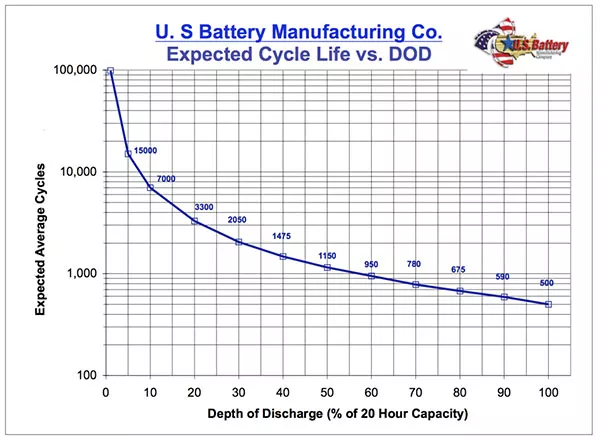
Method
Use an instrument like this one can help to record the testing data automatically, some of them have UPS(Uninterrupted Power Supply) function to guarantee a complete testing process and the data integrity.
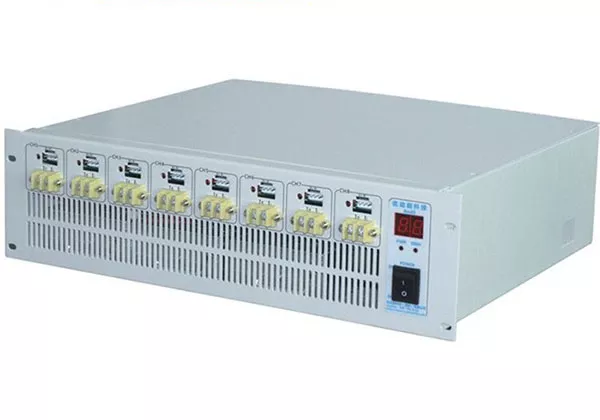
UN38.3 transportation testing for lithium batteries
UN38.3 is for the safety of transportation of batteries or products with batteries, it includes 8 test items
Over those procedures, UN38.8 requires there is no leakage, no venting, no disassembly, no rupture, and no fire.
These are more extreme test conditions compared with normal working conditions, products which have passed UN38.3 are definitely able to perform better.
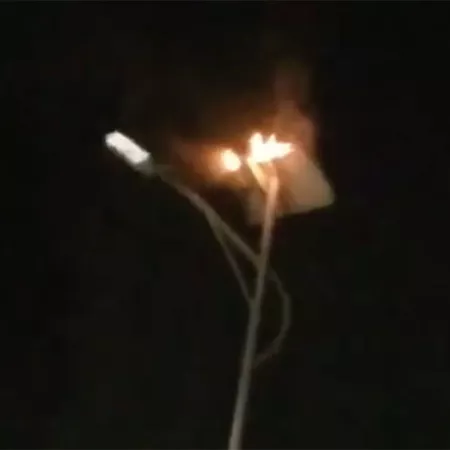
Ingress Protection standard
All in one integrated solar street lights are outdoor lighting, so they have to withstand a hostile environment where they may fail to work because of dust or rainfall.
Ingress Protection(IP) rating is used to define the grades of resistance against dust and water.
Outdoor lighting fixtures are usually with an IP65 rating, which is the highest protection level for outdoor luminaire except for underwater luminaire. The first digit 6 is for dust and the second digit 5 is for water.
Though there is waterproof seals set between the enclosure over the final assembly, those interior components themselves are watertight too. For instance, the wiring connectors are all waterproof, and the controller is IP67 rating.
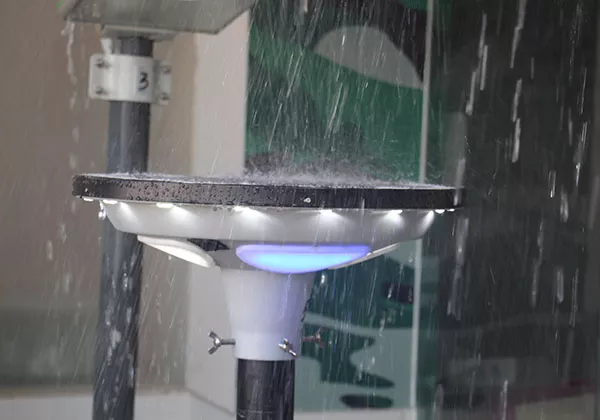
Method
IP65 testing equipment
Apparently, referring to the picture above, a mimic raining environment is necessary for final testing, and it is more useful during the stage of design or pilot production.
If you do not have a spacious site for this kind of voluminous facility, we also suggest seeking a third party laboratory to help you with this work.
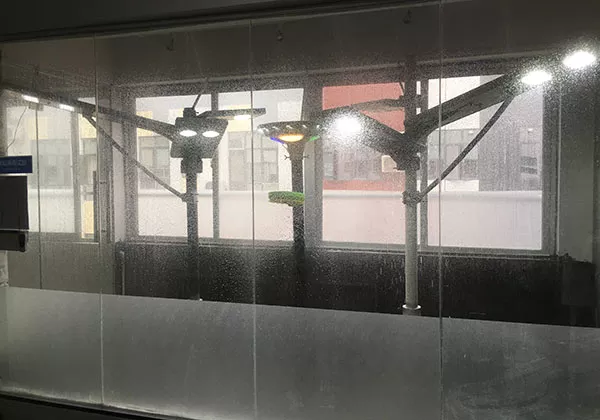
Working Temperature
Outdoor temperature varies with location or season, the working temperature will directly affect the performance of each component or even lifespan in some extreme situations. So either respective modules or assembled products needs testing and monitoring.
Engineering and QC take in charge of these jobs in a factory, when:
As with others, these processes also rely on special tools.
Method
The equipment is used to imitate various working environments to test the tolerance of electronic products. The technician can also set worse working temperature than a real condition to check whether the electronic modules could survive from the testing.
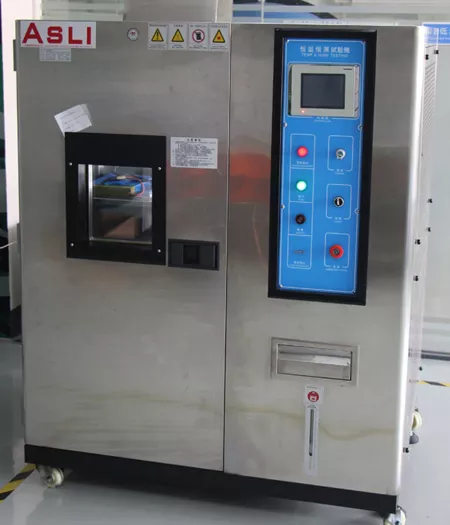
Chapter 6. All in one solar street lights applications
The regions with sufficient sunshine is a must for a solar-powered facility to work normally. The same principle applies to all in one solar street lights. Furthermore, as an off-grid solar-powered product, all in one integrated solar street lights can be used in remote areas where there is devoid of the infrastructure of the power station, such as islands, famous mountains surmounted by beauty spots, or some countryside.
However, as lighting products, all in one integrated solar street lights are mainly installed in the outdoor sites where illumination is required at night.
These sites are generally classified into four different areas as below:
1. Roadways
Fixtures: roadway lighting, street lighting
Locations: highway, road, motorway, lane,
Roadways represent a variety of ways for vehicle traffic. These ways require narrow beam angle across the road and wide beam angle along the road, for this can increase pole spacings and reduce the numbers of streetlights on it.
Recommend :
Type II, Type III
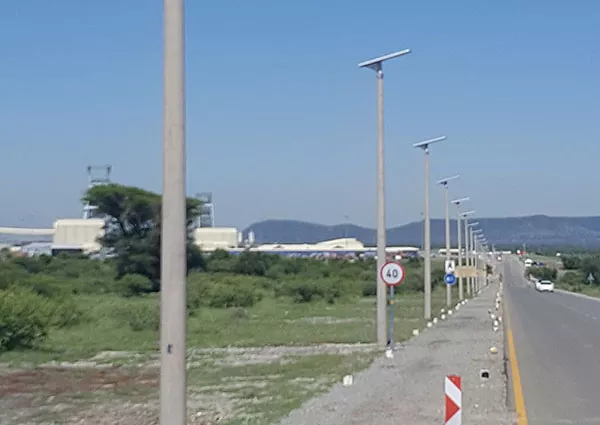
2. Open Areas
Fixtures: parking lot lighting, park lighting, playground lighting, airport lighting, outdoor security lighting(sometimes with cameras)
Locations: airport, park, garden, parking lot, playground, tennis court, outdoor basketball court, intersections
Open Areas often connect vehicle traffic to pedestrian traffic, including the locations with public activities, such as the park, garden, and the places where security monitoring is always processing, such as parking lot, intersections.
these areas need illumination solution at night for either human activities or the scrutiny of the safety and security.
Recommend light distribution types:
Type II, Type III, Type V,

3. Pedestrian Areas
Fixtures: pathway lighting
Locations: plazas, courtyards, and pathways
Pedestrian areas indicate the transition between the building and its surrounding sites since these transition areas cover irregularly shaped spaces, more lighting distribution types may require for this kind of projects.
Recommend light distribution types:
Type II, Type III, Type IV, Type V,
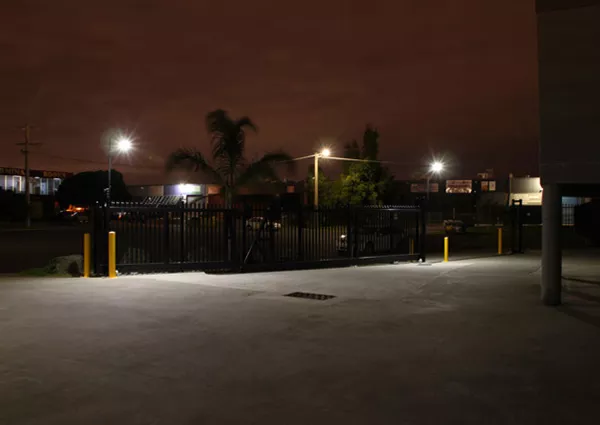
4. Site Perimeter
Fixtures: Perimeter lighting, site lighting,
Locations: factory perimeter, industrial zone perimeter
Some sites, for instance, your villa, require illumination around its perimeter and exclude illumination onto the site itself, for at night you do not expect the street light trespass on your private space, especially bedroom.
Recommend light distribution types:<
Type II, Type III, Type IV,
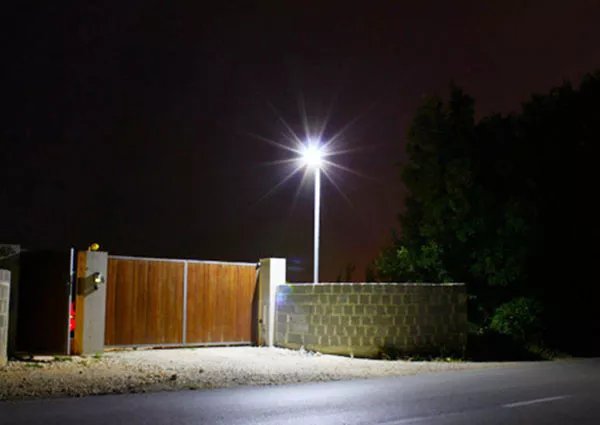
Type II lens for all in one integrated solar street lights
In the MH/HPS ages, this kind of lighting bulbs have to rely on reflector cup to shape special light distribution types on the ground, those cups usually installed above the bulbs, this is another reason why old street lights are too big to be integrated.
Whereas in LED ages, engineers only need to have a thin lens installed onto the LED to realize various light distribution types.

Chapter 7. how to design a project with all in one solar street lights(Case study)
Here is a real-life inquiry from Oman.
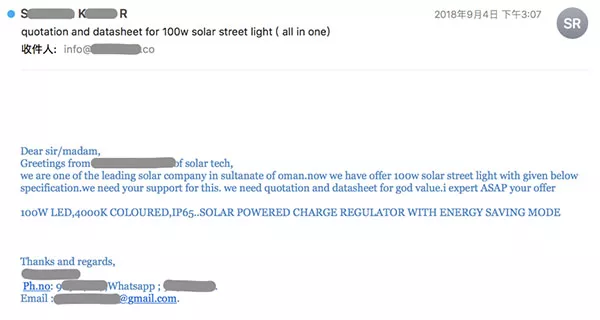
First email
Since there is lack of detailed information for designing a project, so we ask for more information, and the customer sends them in attachments
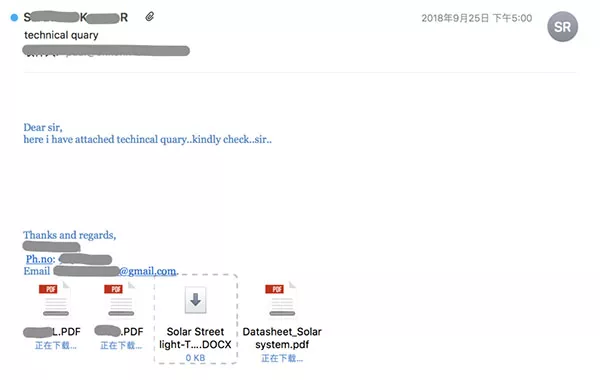
Second email
We spent some time to study and organize the information from the emails
At last, the customer’s requirements are listed below
The engineering process started firstly from checking the existed IES files to guarantee the 5 lux optical requirement on the ground
let’s go through the steps one by one.

design a project with all in one solar street lights
Step 1: check IES datasheet
Our 100w happens to be tested at the mounting height 10 m ( MH = 10 m), and it central illuminance can reach around 8 lux,
(tips: if the mounting height is 7 meters in your project, you need to multiply factor 2.041 in the right column to get relevant lux data on the ground)
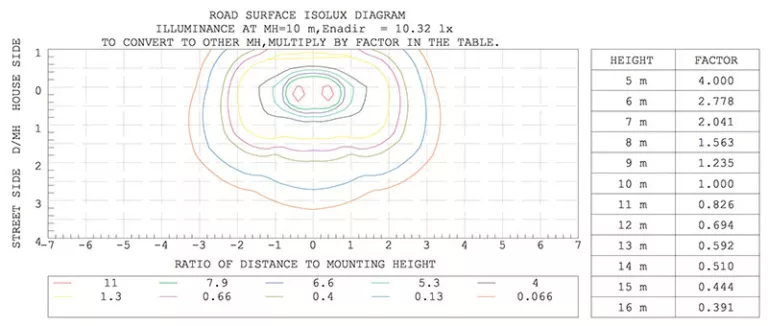
Step 2: adjust the distance between the poles
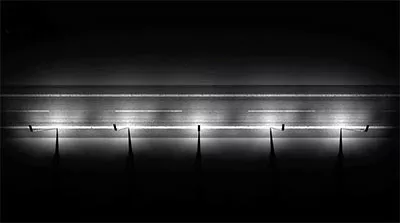
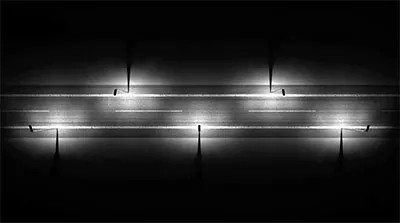
After adjustment
In the course of simulation of engineering, IES files and Dialux can help engineers to get appropriate pole distance pretty easily.
process?
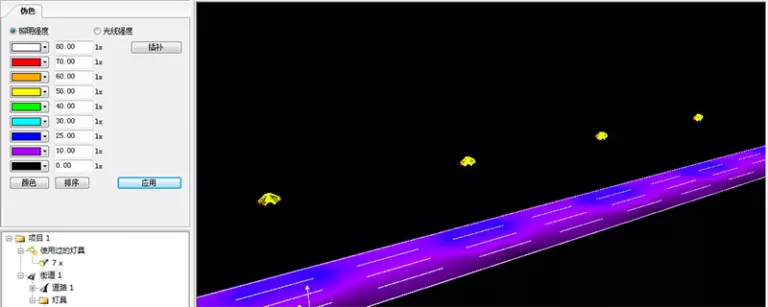
In the end, we decide 25 meters is the best pole distance. And at this time, the minimum illuminance is about 7 lux.
Step 3. Calculate the battery size
So far, optical parameters and installation positions have all been determined.
Next, we need to size the solar battery according to requirements, 12 hours/day and 5 days backup
Step 4. Calculate the solar panel size
The final step is to size the solar panel according to battery size 84AH and the peak sun hours
Our 100w model is equipped with a 170w monocrystalline solar panel.
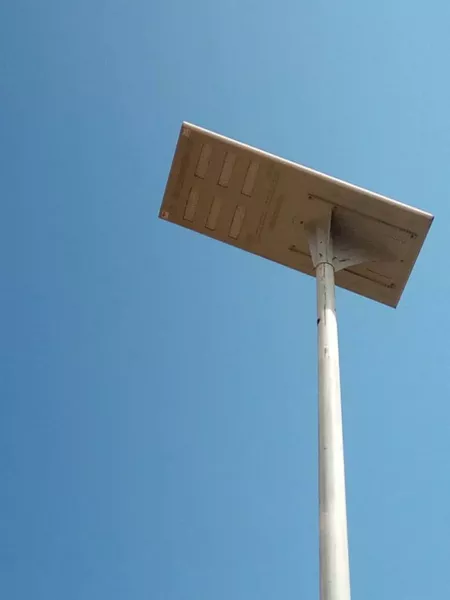
So, finally, we prepare the products with recommended parameters as below
All in one solar street lights is a new trendy type of solar street lights, And this trend will be strengthened as the development of sodium-ion batteries, which is even powerful than current lithium-ion batteries.
Although it may take some time for sodium-ion batteries to go out from the laboratory to real-world applications, it is worth expecting. And at that time, solar street lights will be powerful enough to replace all streetlights.
Depth Analysis of LED Street Light Vs HPS Lamp, LED vs HPS Street Lights, Which is Better
View detailsDie-Casting Aluminum Vs. Extrusion Aluminum Vs. Stamping Aluminum for LED Light Heatsink
View detailsAnalysis 1000W High Mast LED Light for Football Stadium
View detailsPolycrystalline vs Monocrystalline Solar Panel, Which one is better?
View details
HelloPlease log in